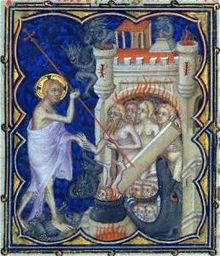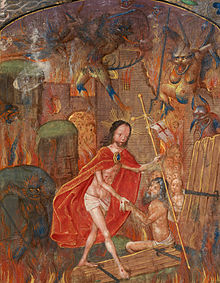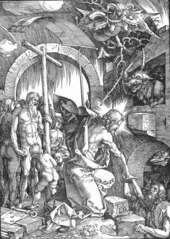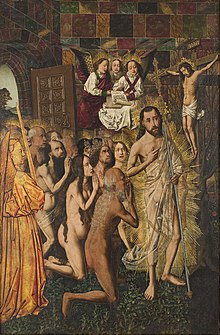The Apostles' Creed, sometimes titled the Apostolic Creed or the Symbol of the Apostles, is a Christian creed or "symbol of faith".
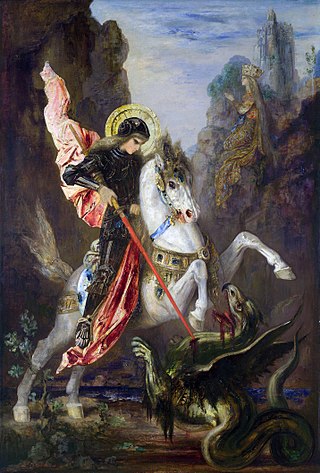
Christian mythology is the body of myths associated with Christianity. The term encompasses a broad variety of legends and narratives, especially those considered sacred narratives. Mythological themes and elements occur throughout Christian literature, including recurring myths such as ascending a mountain, the axis mundi, myths of combat, descent into the Underworld, accounts of a dying-and-rising god, a flood myth, stories about the founding of a tribe or city, and myths about great heroes of the past, paradises, and self-sacrifice.

In Catholic theology, Limbo is the afterlife condition of those who die in original sin without being assigned to the Hell of the Damned. However, it has become the general term to refer to nothing between time and space in general. Medieval theologians of Western Europe described the underworld as divided into three distinct parts: Hell of the Damned, Limbo of the Fathers or Patriarchs, and Limbo of the Infants. The Limbo of the Fathers is an official doctrine of the Catholic Church, but the Limbo of the Infants is not. The concept of Limbo comes from the idea that, in the case of Limbo of the Fathers, good people were not able to achieve heaven just because they were born before the birth of Jesus Christ. This is also true for Limbo of the Infants in that simply because a child died before baptism, does not mean they deserve punishment, though they cannot achieve salvation.

The resurrection of Jesus is the Christian event that God raised Jesus from the dead on the third day after his crucifixion, starting – or restoring – his exalted life as Christ and Lord. According to the New Testament writing, Jesus was firstborn from the dead, ushering in the Kingdom of God. He appeared to his disciples, calling the apostles to the Great Commission of forgiving sin and baptizing repenters, and ascended to Heaven.

The Last Judgment is a concept found across the Abrahamic religions and the Frashokereti of Zoroastrianism.
The problem of Hell is an ethical problem in the Abrahamic religions of Christianity and Islam, in which the existence of Hell or Jahannam for the punishment of souls in the afterlife is regarded as inconsistent with the notion of a just, moral, and omnipotent, omnibenevolent, omniscient supreme being. Also regarded as inconsistent with such a just being is the combination of human free will, and the divine qualities of omniscience and omnipotence, as this would mean God would determine everything that has happened and will happen in the universe—including sinful human behavior.
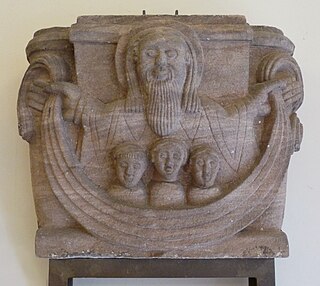
The Bosom of Abraham refers to the place of comfort in the biblical Sheol where the righteous dead await Judgment Day.

In religion and folklore, hell is a location or state in the afterlife in which souls are subjected to punitive suffering, most often through torture, as punishment after death. Religions with a linear divine history often depict hells as eternal destinations, the biggest examples of which are Christianity and Islam, whereas religions with reincarnation usually depict a hell as an intermediary period between incarnations, as is the case in the Indian religions. Religions typically locate hell in another dimension or under Earth's surface. Other afterlife destinations include heaven, paradise, purgatory, limbo, and the underworld.
The fate of the unlearned, also known as the destiny of the unevangelized, is an eschatological question about the ultimate destiny of people who have not been exposed to a particular theology or doctrine and thus have no opportunity to embrace it. The question is whether those who never hear of requirements issued through divine revelations will be punished for failure to abide by those requirements.

Particular judgment, according to Christian eschatology, is the divine judgment that a departed (dead) person undergoes immediately after death, in contradistinction to the general judgment of all people at the end of the world.

In Christian theology, Hell is the place or state into which, by God's definitive judgment, unrepentant sinners pass in the general judgment, or, as some Christians believe, immediately after death. Its character is inferred from teaching in the biblical texts, some of which, interpreted literally, have given rise to the popular idea of Hell. Theologians today generally see Hell as the logical consequence of rejecting union with God and with God's justice and mercy.
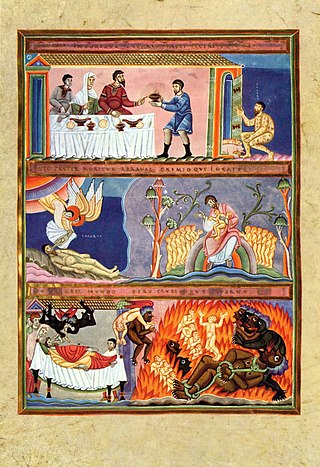
Hades, according to various Christian denominations, is "the place or state of departed spirits", borrowing the name of Hades, the name of the underworld in Greek mythology. It is often associated with the Jewish concept of Sheol. In Christian theology, Hades is seen as an intermediate state between Heaven and Hell in which the dead enter and will remain until the Last Judgment.

In some forms of Christianity, the intermediate state or interim state is a person's existence between death and the universal resurrection. In addition, there are beliefs in a particular judgment right after death and a general judgment or last judgment after the resurrection. It bears resemblance to the Barzakh in Islam.
Catholic theology is the understanding of Catholic doctrine or teachings, and results from the studies of theologians. It is based on canonical scripture, and sacred tradition, as interpreted authoritatively by the magisterium of the Catholic Church. This article serves as an introduction to various topics in Catholic theology, with links to where fuller coverage is found.
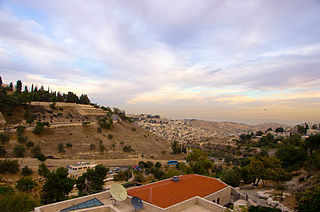
The Valley of Hinnom, Gehinnom or Gehenna, also known as Wadi el-Rababa, is a historic valley surrounding Jerusalem from the west and southwest that has acquired various theological connotations, including as a place of divine punishment, in Jewish eschatology.
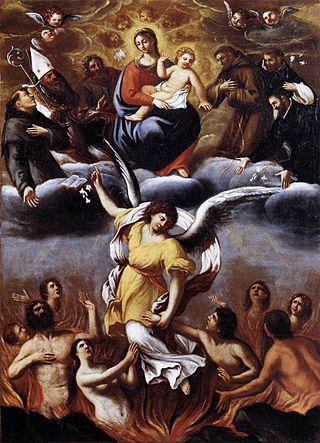
Purgatory is a passing intermediate state after physical death for purifying or purging a soul. A common analogy is dross being removed from gold in a furnace.
Christian theology is the theology – the systematic study of the divine and religion – of Christian belief and practice. It concentrates primarily upon the texts of the Old Testament and of the New Testament, as well as on Christian tradition. Christian theologians use biblical exegesis, rational analysis and argument. Theologians may undertake the study of Christian theology for a variety of reasons, such as in order to:
The spirits in prison is a recurrent minor subject in the writings of Christianity.
General resurrection or universal resurrection is the belief in a resurrection of the dead, or resurrection from the dead by which most or all people who have died would be resurrected. Various forms of this concept can be found in Christian, Islamic, Jewish, Samaritan and Zoroastrian eschatology.
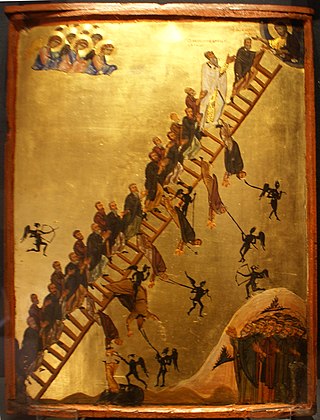
Eternal life traditionally refers to continued life after death, as outlined in Christian eschatology. The Apostles' Creed testifies: "I believe... the resurrection of the body, and life everlasting." In this view, eternal life commences after the second coming of Jesus and the resurrection of the dead, although in the New Testament's Johannine literature there are references to eternal life commencing in the earthly life of the believer, possibly indicating an inaugurated eschatology.
